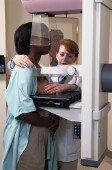Basal-Like Breast CA Equally Aggressive for Different Races
Basal-like breast cancer is not more aggressive among African-American individuals than whites; however, in patients with luminal A cancer, African-American women experience worse outcomes, according to a study published in the Dec. 15 issue of Clinical Cancer Research.

WEDNESDAY, Jan. 19 (HealthDay News) -- Basal-like breast cancer is not more aggressive among African-American individuals than whites; however, in patients with luminal A cancer, African-American women experience worse outcomes, according to a study published in the Dec. 15 issue of Clinical Cancer Research.
Katie M. O'Brien, of the University of North Carolina in Chapel Hill, and colleagues used immunohistochemical markers to subtype 1,149 invasive breast cancer patients (518 African-American, 631 white) in the Carolina Breast Cancer Study.
Among whites, cancer subtypes luminal A, luminal B, basal-like, and human epidermal growth factor receptor 2 positive/estrogen receptor negative (HER2+/ER−) were distributed as 64, 11, 11, and 5 percent, respectively. The investigators also found that these subtypes were distributed as 48, 8, 22, and 7 percent, respectively, for African-Americans. Compared to participants with luminal A and B subtypes, breast cancer mortality was higher among participants with HER2+/ER− and basal-like breast cancer. African-Americans had higher breast cancer-specific mortality than whites; however, the effect of race was statistically significant only among women with luminal A breast cancer. Compared with participants with luminal A subtype within racial categories, mortality for participants with basal-like breast cancer was higher among whites than African-Americans.
"Although race should not matter after diagnosis, as the authors appropriately note, race does matter. Issues involving racial differences in breast cancer treatment and access to care continue to drive many of the disparities in outcome," writes the author of an accompanying editorial.
AbstractFull Text (subscription or payment may be required)Editorial (subscription or payment may be required)
Related ContentGermline BRCA1 mutations appear to be associated with breast cancer phenotype Positive Association Between Mammographic Breast Density and Bone Mineral Density in the Postmenopausal Estrogen/Progestin Interventions Study
Integrating HCV screening with breast cancer programs enhances care
June 25th 2024A recent study from France demonstrates that incorporating hepatitis C virus screening into breast cancer programs significantly improves patient engagement and access to effective antiviral treatments among older women.
Read More
